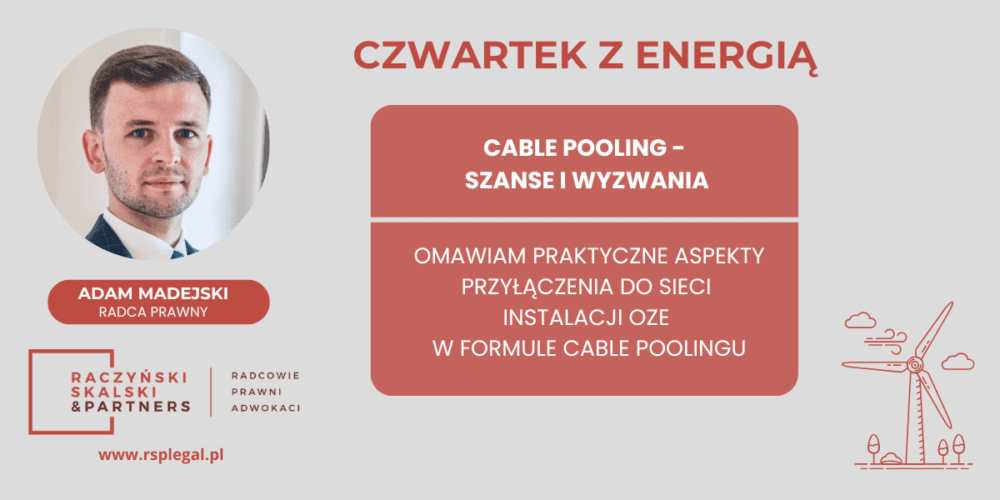The introduction of cable pooling, or so-called shared connection, into the electricity law has been met with optimism in the RES industry. With this solution, two or more installations can use a single point of connection to the grid, thus optimizing generation capacity with limited technical capabilities of the grid. The most popular model seems to be a combination of photovoltaic and wind sources, but in this respect there is no obstacle to other types of sources, such as hydroelectric or biogas plants.
1. Cable pooling – where to start?
It is worth thinking about a shared connection when the location conditions allow diversification of generation possibilities (for example – the already mentioned generation of energy simultaneously from wind power and solar radiation or orientation of photovoltaic power plants to different directions of the world). This solution also makes sense when more than one investor is considering the construction of a RES installation, and the available grid connection capacities are limited.
Whether one entity or several are interested, the following questions are worth answering at the planning stage:
-
- What potential for RES does the location have and how can it best be used?
- What connection conditions can be counted on within the available section of the grid?
- Do local acts allow not only for the construction of generation sources of the appropriate capacity and type, but also for the location of energy storage?
- Can operating costs be optimized within the contemplated location, for example, by sharing the lease of real estate for the construction work of several installations?
If the answers to the above and other questions point toward the choice of cable pooling, and there are at least two future owners of generation facilities, one can move on to preparing one of the most important issues – the generators’ agreement.
2. Agreement of manufacturers – practical aspects
Article 7(3de)(1) of the Energy Law requires that entities jointly applying for cable pooling terms and conditions enter into an agreement between themselves that will regulate certain issues. The statutory catalog is not closed, which means that there are no obstacles to the scope of such an agreement going beyond the Energy Law.
It is mandatory that the agreement should include:
-
-
- The data of the parties, the parameters of the installations belonging to them and the determination of the rights to which the parties are entitled with respect to these installations,
- The rules for the joint execution of rights and obligations with respect to the execution of the terms and conditions for connection, the grid connection agreement, and agreements for the provision of distribution or transmission services,
- Principles of sharing the available connection power and location of metering equipment,
- Identification of the entity that will act as a representative of generators in relations with the distribution system operator and the Energy Regulatory Office, including being a party to grid connection agreements and agreements for the provision of distribution or transmission services to all installations,
- Rules for the distribution of compensation funds for making non-market redispatch.
-
However, it is impossible to stop at regulating only the above issues. In practice, the agreement should cover a number of other issues, as well as safeguard all parties to the agreement throughout the planned period of operation of the investment. In this regard, it is worth taking into account first of all:
-
-
- Rules for new entities to join the agreement and conditions for cancellation – all generators involved in the cable pooling formula should be aware that, as a rule, this will be a long-term investment. During its duration, various events may occur that may significantly affect the operation of generation facilities. To this end, the parties to the agreement should work out both the rules for joining and leaving the agreement.
- Principles of financial responsibility of individual entities – although Article 7, paragraph 3de, item 6 of the Energy Law requires that the parties to the agreement undertake to be jointly and severally liable to the operator for exceeding the connection capacity, nothing prevents the agreement from simultaneously establishing other principles of settlement, the necessity for which is bound to arise in the course of operation of the installation, in particular, it is a matter of incurring expenses for maintenance of elements of the connection, common property or reimbursement of amounts paid by one of the parties to the infringement case in connection with joint and several liability.
- Arrangements for the possibility of changing the rules of use of the assigned power – if there are generation sources of different types operating within a shared connection, it may happen that in different years the generation capacity of individual installations will change. In this case, it is good to regulate the proportion in which these installations will use the available connection capacity.
- Rules for deciding on the operation of individual installations in the event of extraordinary events – in this case it is not just a case of force majeure events, but also changes in the electricity market, changes in the law or, finally, a change in the financial situation of one of the participants in the agreement, burdening the other parties. In order to fully prepare for cable pooling cooperation, it is worth preparing for various scenarios. The agreement itself does not have to be very casuistic in this case, as it is possible to introduce a general formula of conduct that will give each participant certainty about how to act in the event of a specific event.
- Rules for the use of stored energy – in the case of the installation of energy storage within an installation covered by a shared connection, it is worth determining whether the stored energy will be available to all participants and how its management will take place.
- Rules for co-management of installations – this option should be considered by generators who are simultaneously engaged in the business of electricity trading. In such an option, the agreement can regulate the rules for the use and billing of energy generated at all or some installations, so as to increase their competitiveness through economies of scale.
- Rules for changing the content of the agreement – although this issue seems mundane, it is impossible to diminish its importance. In practice, the lifespan of RES installations is more than 20 years, so it is worth determining from the very beginning how the parties to the agreement will be able to initiate, negotiate and enforce changes in the content of the agreement.
-
3. Upcoming opportunities and challenges
Cable pooling is a forward-looking solution that may become particularly important if the announced legal changes to so-called flexible connection agreements and the reform of the institution of connection on a commercial basis are implemented. Combined with the growing interest in energy storage, we may get a vehicle that will make the best use of available renewable energy opportunities.
In the context of the announced reform of grid connection rules, cable pooling may prove to be the best solution, particularly if the lead time of individual investments differs and the available connection capacity in a given location increases with grid development or modernization.
It is also worth considering involved in cable pooling when the terrain conditions allow for the co-use of a single property for the construction and operation of several installations, for example, as a materials storage, technical base or maneuvering area, and the available connection capacity will allow investors to realize their intentions.



